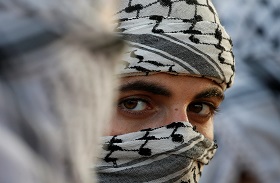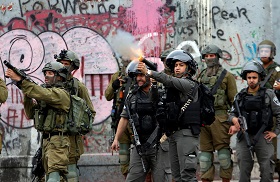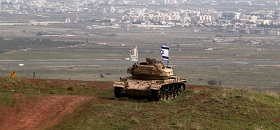Israel’s Security System: Little Strategic Depth but Profound Strategic Vision
(votes: 1, rating: 5) |
(1 vote) |
Postgraduate student, MGIMO University
The Israeli army is among the best-equipped and most combat-ready in the world, and the quality of its equipment is constantly being improved.[i] The country’s defence industry has been expanding since the early 1970s, so that now Israel can manufacture domestic examples of state-of-the-art systems, from tanks and fighter jet modifications to precision smart weapons (microelectronics, anti-ship and air-to-air missiles, etc.). Israel exports some 75–80 per cent of its military output through the Ministry of Defence’s International Defence Cooperation Directorate (SIBAT). Another structure of the Ministry of Defence, the Procurement and Production Administration (MANHAR), coordinates weapons production and deliveries to the Israeli Defence Forces, as well as procurement of foreign-made equipment.
The Israeli Ministry of Defence coordinates all research and development activities related to the country’s defensive capacity. At present, the country’s multisectoral defence industry is focused on developing increasingly more advanced and sophisticated weapons and equipment. Despite the permanent need for deliveries of advanced weapon systems to the Israeli security agencies, the country’s defence industry is primarily focused on exporting its products. Between 2013 and 2017, Israel rose from 10th to 8th in the global ranking of arms exporters. Its share of the global arms market stands at 2.9 per cent, compared to France’s 6.7 per cent.
The main problem for Israel is Iran’s desire to create nuclear weapons. The country views such a development as a direct threat to its very existence, and its government and military command are taking every step to prevent it. All possible options are being considered, including armed hostilities. Israel will continue to be a “besieged fortress,” building its military potential and keeping its special services in top shape.
The Israeli army is among the best-equipped and most combat-ready in the world, and the quality of its equipment is constantly being improved [2]. The country’s defence industry has been expanding since the early 1970s, so that now Israel can manufacture domestic examples of state-of-the-art systems, from tanks and fighter jet modifications to precision smart weapons (microelectronics, anti-ship and air-to-air missiles, etc.). Israel exports some 75–80 per cent of its military output through the Ministry of Defence’s International Defence Cooperation Directorate (abbreviated to SIBAT). Another structure of the Ministry of Defence, the Procurement and Production Administration (abbreviated to MANHAR), coordinates weapons production and deliveries to the Israeli Defence Forces, as well as procurement of foreign-made equipment.
The Israeli Ministry of Defence coordinates all research and development activities related to the country’s defensive capacity. At present, the country’s multisectoral defence industry is focused on developing increasingly more advanced and sophisticated weapons and equipment. Despite the permanent need for deliveries of advanced weapon systems to the Israeli security agencies, the country’s defence industry is primarily focused on exporting its products. Between 2013 and 2017, Israel rose from 10th to 8th in the global ranking of arms exporters. Its share of the global arms market stands at 2.9 per cent, compared to France’s 6.7 per cent.
One of the key factors influencing the development of Israel’s defence industry is its strategic cooperation with the United States. Since the early 1960s, under the John F. Kennedy administration, Israel has been provided comprehensive and exceptional assistance, including in the form of substantive military support. It was this military aid that allowed Israel to redirect some 80 per cent of its weapons systems for export [3]. This significantly benefited the Israeli defence industry, enabling it to channel the proceeds to the development of new military technology. The money Israel gets from the sale of advanced weapon systems allows the country to stimulate research and development efforts, thus helping it to remain among the global hi-tech leaders.
Israel spares no funds on military research and development, which absorbs around 9 per cent of the country’s military budget. This proportion is much higher than in other countries (for example, Turkey with 1 per cent or South Korea with 5.4 per cent) [access to U.S.-made weapons. Military relations between the two countries are regulated by a broad legislative framework put in place back in 1952 [5]. As part of this assistance, Israel has been receiving hefty sums from the United States: for example, the aid amounted to $2.4 billion in 2001, $2.7 billion in 2007 and, under a 2016 memorandum, a total of $38 billion is to be directed to the country in 2019–2028 (or $3.8 billion annually, excluding additional funds that might be requested through Congress).
U.S. military assistance to Israel is being implemented as part of three main programmes: Foreign Military Sales, Direct Commercial Sales and Excess Defence Articles [6]. An important condition for the provision of this assistance is that Israel is obliged to spend most of the funds received on the procurement of U.S. military products, which allows the U.S. administration to finance its domestic defence industry [7]. Only about 25 per cent of the military aid received from the United States may be spent at Israel’s discretion. This is an exclusive privilege denied to other recipients of U.S. military assistance. In addition to the financial component of military aid and arms imports, Israel also has access to joint military development programmes. One such programme is to develop the Boeing F-35 fifth-generation fighter. Israel was made a partner on the project in 2003. In 2016, as a launch customer, it took delivery of its first two aircraft (out of 19 on order).
At present, Israel is actively at work to develop a national multitier system to counter short- and medium-range missiles. One component of this system is known as the Iron Dome, which proved its worth during Israeli’s recent operations in the Gaza Strip. The Iron Dome represents the lower tier of Israel’s missile defence shield. It is capable of detecting, intercepting and destroying short-range missiles. The system provides early missile detection, calculates the target’s trajectory and then decides whether or not to engage the target. The Iron Dome only engages those missiles which are likely to reach their targets, and ignores those which are likely to miss. In 2013, the United States allocated $680 million for the development of this project, followed by a further $225 million in 2015 [8].
Despite all this, there is no treaty in place between Israel and the United States on mutual assistance in the event of a military conflict. Israel’s status as Washington’s key ally outside NATO only gives the former preferences when it comes to defence cooperation. In fact, the U.S. defence industry is also interested in a high level pf cooperation with Israel, even though Tel Aviv spends the money received from the United States on U.S.-made weapons. U.S. defence companies are able to participate in Israeli projects to produce advanced equipment, like the Iron Dome and the Magic Wand (currently known as David’s Sling, which is designed to intercept short-range ballistic missiles [with ranges between 70 and 300 kilometres]) [9]. The latter is to become the middle link in Israel’s missile defence system. Israel is gradually turning from a recipient of U.S. military assistance into a partner, as the defence industries of the two countries are increasingly integrating and implementing joint projects. This process is aided by the nearly comparable levels of scientific and technological development, allowing the parties to cooperate on complex hi-tech projects.
Army and Special Services

Israel and Gaza: Determination vs. Desperation
The Israel Defence Forces (IDF, or Tzahal in Hebrew) were created in May 1948. Israel has not had an official national security doctrine since its first prime minister, David Ben-Gurion. The most recent attempt to develop such a document was in 2004–2007, by the Meridor Commission. The draft was not approved by the government [10].
The main doctrine governing the Israeli government’s political decision-making and the development of specific military strategies was drawn up in 1949 by a committee led by then colonel of the Israel Defence Forces Haim Laskov [11, 12]. , The document reads that Israel will always be inferior to its potential adversaries in the region in terms of its population size. It also aims to prevent subsequent generations of Israeli politicians from succumbing to the illusion that the main problem of the Arab–Israeli conflict is one of borders. Specifically, the problem lies in the very fact of Israel’s existence: its opponents are intent on nothing less but its total annihilation [13]. The doctrine stresses that Israel has no strategic depth (the minimum distance from the border to the sea being just 14 kilometres), and that it will have to wage war against a numerically superior adversary, meaning that the potential enemy will be impossible to destroy completely. The main objective of any war, therefore, should be to cause maximum possible damage to the enemy, thus forcing it to end the conflict [14]. In addition, Israel’s economy will not be able to sustain any protracted conflict, so the Israel Defence Forces need to secure their objectives as promptly as possible.
At the moment, the IDF’s defence budget amounts to approximately $17 billion (compared to some $12 billion for Iran and $6 billion for Egypt). The IDF’s regular troops stand at 176,000. Military service is mandatory for both men and women, and there are around 560,000 reservists could be mobilized if need be. The Israel Defence Forces are subordinate to the government in the person of the Minister of Defence [15]. The Ministry of Defence reports on defence policy and planning to the Foreign Affairs and Defence Committee. Operational command is carried out by the General Staff of the Israel Defence Forces, which comprises six directorates [16]: the Operations Directorate; the Intelligence Directorate; the Manpower Directorate; the Technological and Logistics Directorate; the Weapons Research and Development Directorate; and the Planning Directorate. The General Staff also includes a division for combat training and special operations.
The Army, Air Force and Navy have their own separate commands, all reporting to the General Staff. The Israel Defence Forces are capable of mobilizing most of the reserve forces within 24 hours. Another important part of Israel’s military strategy [17] involves transferring the hostilities to the enemy territory, taking them as far away as possible from the state border and quickly moving troops between the different fronts. Israel is currently one of the few countries whose army is capable of network-centric warfare, with all combat units interacting within a single network. Network-centric warfare is the prerogative of “highly intelligent armies,” which obtain intelligence as part of comprehensive battlefield surveillance. This enhances the effectiveness of all the military units, increases the pace of operations and provides for the assured destruction of enemy forces [18].
Israel spares no funds on military research and development, which absorbs around 9 per cent of the country’s military budget. This proportion is much higher than in other countries (for example, Turkey with 1 per cent or South Korea with 5.4 per cent).
Tzahal’s primary strike force is the Air Force, with 36,000 personnel and 400 combat aircraft. The Israeli Air Force commands around 300 locally modified fourth-generation fighters (F-15s and F-16s), and will shortly receive a batch of fifth-generation F-35s from the United States. Israel has the right to retrofit U.S.-made aircraft with domestically produced avionics. The Israeli Air Force also has a wide range of homemade UAV of different classes, which can be used for engaging enemy radars, reconnaissance, fire adjustment and search and rescue. This is currently the most powerful air force in the region in terms of equipment and pilot training, and also as a result of extensive experience of wars, military operations and individual missions.
In contrast to the Army and Air Force, the size of the Israeli Navy is not that big, with 12,000 personnel. It is commanded by a vice-admiral, who reports to the commander of the General Staff of the Israel Defence Forces. Structurally, the Navy comprises a missile-boat flotilla, a submarine flotilla, three patrol squadrons and the Shayetet 13 flotilla. Enlisted personnel are recruited, whereas all the commissioned officers and non-coms are career servicemen. The senior officers undergo training in the city of Haifa; the officer corps includes officers who have served in the rank for at least two years, and graduates of the Acre-Akko Nautical College.
At the moment, the IDF’s defence budget amounts to approximately $17 billion (compared to some $12 billion for Iran and $6 billion for Egypt). The IDF’s regular troops stand at 176,000.
The Navy’s primary objectives are as follows:
- To protect the country’s coasts, sea ports and naval stations;
- To protect shipping lanes;
- To provide support for ground troops;
- To uphold the blockade of the enemy sea coast.
The Navy operates three bases, one each in Haifa, Eilat and Ashdod.
According to available sources [19], the Haifa base is home to the 3rd (Missile–Boat) Flotilla, the 7th (Submarine) Flotilla and the 914th Patrol Squadron. The Ashdod base houses the 916th Patrol Squadron, while the 915th Patrol Squadron is stationed at the Eilat base. The Israeli Navy also includes two helicopter regiments with a total of 42 aircraft.
In addition from missile and patrol boats, the Navy operates Sa’ar 5-class corvettes with a total displacement of 1250 tonnes. These corvettes were built at the Ingalls Shipbuilding shipyard in the United States between 1992 and 1995, and are the flagships of the Israeli Navy. The submarine fleet comprises five German-built Dolphin class diesel-electric submarines. Priced at $700 million apiece, these are the most expensive examples of weapon systems operated by Israel. The submarines are capable of carrying cruise missiles, possibly including nuclear-tipped missiles [20]. The fact that the Israeli Navy has this class of vessels in its arsenal significantly expands its operational capability and ensures its superiority over the navies of neighbouring countries [21].
During the 2006 military operation in Lebanon, the Israeli Navy successfully performed a range of functions, including a blockade of the Lebanese coast, fire support for the ground troops and special forces operations.
Shayetet 13, the Israeli Navy’s naval commando unit, is among the elite Tzahal forces. Its operations are highly classified [22]. , Candidate commandos are subjected to strict selection and medical inspections. The Shayetet 13 boot camp is considered to be the most difficult within the IDF, with most recruits failing to pass the selection due to the high physical and mental loads [23].
Special Services and Threats to Security
All the known Israeli special services are united under the aegis of the Committee of the Chiefs of Services (abbreviated to Varash in Hebrew). These include the chiefs of Mossad (overseas intelligence), Shabak (homeland security, counterintelligence and the war on terrorism) and Aman (the Directorate of Military Intelligence), as well as the chief police inspector.
The primary objectives of the special services include: intelligence gathering on the Arab states and Iran (their relations with other states, their defensive capacity, domestic and intra-Arab policy); intelligence gathering on the U.S. political elite; intelligence gathering on the Israel-oriented policies of countries with large Jewish diasporas; and surveillance of anti-Zionist activities around the world. Information about these agencies’ budgets, operations and personnel is classified.
Shabak focuses on counterintelligence and homeland security [24]. It counteracts foreign intelligence services and Palestinian Arabs. The agency is directly subordinate to the Prime Minister of Israel. The agency rose to prominence during the so-called Al-Aqsa Intifada, which began in 2000. Shabak utilises unique anti-terrorist methods and technologies, including a comprehensive network of agents in Palestine [25]. Intelligence obtained in the course of interrogations is then analysed and used in the planning of operations to eliminate, with the prime minister’s approval, persons whom Israel believes present a threat to its security.
The primary objectives of the special services include: intelligence gathering on the Arab states and Iran; intelligence gathering on the U.S. political elite; intelligence gathering on the Israel-oriented policies of countries with large Jewish diasporas; and surveillance of anti-Zionist activities around the world.
Mossad gathers foreign intelligence and carries out clandestine operations abroad. There is scarce open-source information about this agency; any details of its activities either surface many years afterwards or get leaked to the press following botched operations. Even the name of the Mossad director was not revealed until the late 1990s. The agency primarily recruits from Israeli citizens, and it is impossible for an outsider to assess the number of personnel employed [26]. The social and cultural diversity of settlers arriving in Israel has enabled Mossad to raise the efficiency and effectiveness of its operations, as its officers offer a variety of cultural traits, complexions and linguistic skills. For this reason, the agency has no problem infiltrating illegal operatives within short periods of time. Mossad is a civilian agency so does not use military ranks. However, most of its officers have served in the army. Some of the service’s most successful operations were the capture of former Nazi criminal Adolf Einchmann in 1960, Operation Damocles targeting German scientists involved in Egypt’s ballistic missile programme, Operation Wrath of God to eliminate those involved in the terrorist attack at the Munich Olympics, operations against the Iraqi nuclear programme, and the 1988 assassination of Fatah co-founder Khalil Ibrahim al-Wazir in Tunisia. Mossad is also suspected of being involved in the disappearance of former deputy Minister of Defence of Iran and Commander of the Islamic Revolutionary Guards Corps, General Ali-Reza Asgari. The agency’s current mission is to prevent Iran from developing its nuclear capability for as long as possible.
Aman, the Directorate of Military Intelligence, reports directly to the prime minister [27]. The agency is responsible for strategic and tactical intelligence, as well as for the development and safeguarding of communications codes and ciphers for all the Israeli governmental departments and special services. It also collects and analyses intelligence on the Arab countries’ armies and terrorist organizations. Aman comprises two primary services, each commanded by a major-general:
- the intelligence service (responsible for training personnel); and
- the intelligence analysis service (which analyses intelligence for the government and the military command).
There is also a supervision department, which subjects the intelligence analysis service’s reports to critical reviews.
Aman includes the following units [28]:
Unit 8200, which is responsible for collecting signals intelligence. According to certain reports, this is the IDF’s largest unit, similar in functions to the U.S. National Security Agency [29]. It is commanded by a brigadier general whose identity is classified. According to available data, Unit 8200 wiretapped the phones of President of Egypt Gamal Abdel Nasser and King Hussein of Jordan during the 1967 war, and eavesdropped on the Palestinian leader Yasser Arafat’s telephone conversation with the leader of a terrorist group that had captured a cruise liner in the Mediterranean in 1985. In 2010, it became known that Unit 8200 had been tasked with neutralizing the Syrian air defences during Operation Outside the Box to destroy a Syrian nuclear facility [30]. Many believe the unit responsible for the spread of the computer virus Stuxnet, which infected some 50,000 computers in Iran in 2010, including at the country’s nuclear facilities [31].
Unit 9900, which collects airborne and space-based intelligence.
Unit 3060, which conducts artificial intelligence-related research and development.
Unit 504, a HUMINT unit with agent and informant networks across the region.
Aman also posts military attaches to Israel’s overseas missions and is responsible for military censorship in the Israeli media.
Conclusion
The possibility of a potential war between Israel and any neighbouring Arab countries is currently negligible: Israel has peace treaties with Egypt and Jordan, which also receive military aid from the United States. Syria, for its part, has been ravaged by civil war. The main threat to Israel remains the unresolved issue with the Palestinian Arabs. In the south, along the Gaza Strip, the terrorist organization Hamas and local minor terrorist groups raise their head periodically. Hamas launches missile into Israeli territory. Israel’s primary regional antagonist is Iran, which denies Israel’s right to exist and pursues an active anti-Israeli policy. In the north, Israel fears short- and medium-range missile attacks from Lebanese-based Hezbollah, which possesses sizable arsenals of such munitions. Hezbollah, which is considered a terrorist organization in Israel, is Iran’s key ally in the region, and is directly bankrolled and armed by Tehran. In addition, Israel fears a second front opening in Syria, where Hezbollah militants and Iranian troops are fighting on the side of the government forces. Israel’s main objective is to prevent the establishment of combat positions and bases in Syria from which Iranian missiles could be launched. The main problem for Israel, however, is Iran’s desire to create nuclear weapons. The country views such a development as a direct threat to its very existence, and its government and military command are taking every step to prevent it. All possible options are being considered, including armed hostilities. Israel will continue to be a “besieged fortress,” building its military potential and keeping its special services in top shape.
1. Shuminov, N. U.S. Influence on the Formation and Development of the Israeli Defence Industry // Bulletin of Bryansk State University. No. 2, 2018, pp. 135–146.
2. Shuminov, N. U.S. Influence on the Formation and Development of the Israeli Defence Industry // Bulletin of Bryansk State University. No. 2, 2018, pp. 135–146.
3. Broude Marc, Deger Saadet, Defence, Innovation and Development: The Case of Israel // Broude M., Deger S. De Boeck Université. 313pp.
4. Broude, Marc and Deger Saadet, Defence, Innovation and Development: The Case of Israel // Broude M., Deger S. De Boeck Université. 313pp.
5. Shuminov, N. U.S. Influence on the Formation and Development of the Israeli Defence Industry // Bulletin of Bryansk State University. No. 2, 2018, pp. 135–146.
6. Stohl, R. The International Arms Trade / Stohl R, Greliot S. War and Conflict in the Modern World., 2013, 67pp.
7. Sharp, J. U.S. Foreign Aid to Israel / Sharp J. Congressional Research Service, 2015, 19pp.
8. “House of Representatives Report 112-479 – NATIONAL DEFENCE AUTHORIZATION ACT FOR FISCAL YEAR 2013,” Retrieved on June 22, 2012.
9. Broude, Marc and Deger Saadet, Defence, Innovation and Development: The Case of Israel // Broude M., Deger S. De Boeck Université. 313pp.
10. Herzog, Michael. New IDF Strategy Goes Public // PolicyWatch, The Washington Institute, August 28, 2015.
11. Handel, Michael I. Israel’s Political-Military Doctrine // Occasional Papers in International Affairs, No. 30. Cambridge, Mass: Harvard University Center for International Affairs, July 1973.
12. Tatarinov, Maj M. Israel’s Military Doctrine // Zarubezhnoye Voyennoye Obozrenie. 2015, No. 6, pp. 23–27.
13. Ibid.
14. Eliezer, Uri Ben. The Making of Israeli Militarism / Indiana University, 1998.
15. Even, Shmuel and Eran Yashiv. The Defence Budget for 2017–2018 / INSS Insight. No. 880, December 28, 2016.
16. Cordesman, A. The Military Balance in the Middle East, An Analytic Overview: Military Expenditures and Arms Transfers, Major Arms by Country and Zone, and Qualitative Trend / Cordesman A., Center for Strategic and International Studies. Washington., 2004, 431 pp.
17. See footnote 21.
18. Dolgopolov, A. Net-Centric Wars Revisited // Armeyskoy Sbornik magazine. 2015. February (Vol. 248, No. 2), pp. 3–6.
19. See footnote 31.
20. Mahnaimi, Uzi. Israel Makes Nuclear Waves With Submarine Missile Test, June 18, 2000.
21. Lappin, Yaakov. Israeli Submarine Chief Outlines Future Requirements / IHS Jane’s Defence Weekly, March 14, 2018.
22. Miller, David. Illustrated Directory of Special Forces // A Salamander book, 2002.
23. See footnote 35.
24. Raviv, Dan and Yossi Melman. Every Spy a Prince. The Complete History of Israel’s Intelligence Community. Moscow: International Relations, 2000. 528pp. (Secret Missions).
25. Freilich, Charles D. Isreli National Security: A New Strategy for an Era of Change / Oxford University Press, 2018.
26. Lapid, Ephraim and Amos Gilboa, Israel's Silent Defender: An Inside Look at Sixty Years of Israeli Intelligence, 2012.
27. Kahana, Ephraim. Historical Dictionary of Israeli Intelligence, The Scarecrow Press, Inc. Oxford, 2006.
28. IDF Record Book 2010 / Bamahane, September 8, 2010.
29. Reed, John. Unit 8200: Israel’s Cyber Spy Agency // Financial Times, July 10, 2015.
30. Israel’s Omniscient Ears. Le Monde Diplomatique, 2010 September. Le Monde Diplomatique.
31. Israel Seen as Prime Cyberattack Suspect. United Press International, October 28, 2010.
(votes: 1, rating: 5) |
(1 vote) |
A Regional Rumble in Syria
Peace in the Middle East: Russia’s Role in the Israeli-Palestinian Conflict Israel and Gaza: Determination vs. DesperationThus far, both parties are interested in war rather than peace
Russia and Israel: The Middle Eastern Vector of RelationsWorking paper 42/2018







